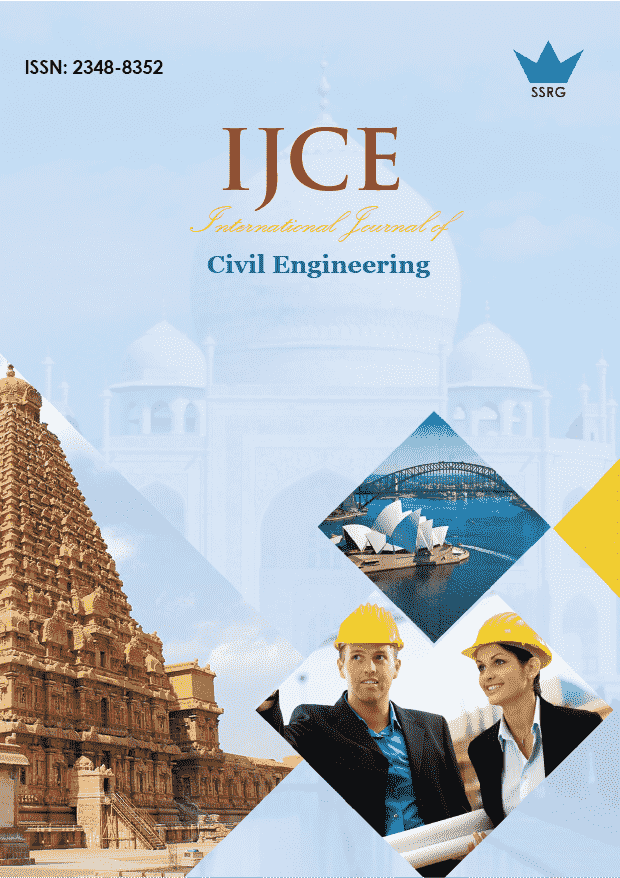Impact of Climatological Parameters on Reference Crop Evapotranspiration Using Multiple Linear Regression Analysis

| International Journal of Civil Engineering |
| © 2015 by SSRG - IJCE Journal |
| Volume 2 Issue 1 |
| Year of Publication : 2015 |
| Authors : H R Mahida, V N Patel |
How to Cite?
H R Mahida, V N Patel, "Impact of Climatological Parameters on Reference Crop Evapotranspiration Using Multiple Linear Regression Analysis," SSRG International Journal of Civil Engineering, vol. 2, no. 1, pp. ):21-24, 2015. Crossref, https://doi.org/10.14445/23488352/IJCE-V2I1P103
Abstract:
The reference crop evapotranspiration (ETo) of Bhaniyara station have been estimated using multiple linear regression (MLR) technique in XLSTAT tool. The meteorological data such as maximum temperatures, sunshine hours, relative humidity and wind speed were collected for the Bhaniyara station of Vadodara district, Gujarat state, India for the period of nine years and the missing value of that data series was also determine using SPSS20 software. The observed ETo values have been estimated using the equation of evapotranspiration (FAO-56).MLR is carried out using ETo as predictor variable and maximum temperatures, sunshine hours, relative humidity and wind speed as independent variable to find out predominant factor on ETo. This whole procedure is done for five different Models. In model 1, Maximum temperature, relative humidity, sunshine hours and wind speed are correlated with ETo. In model 2, Maximum temperature, relative humidity and sunshine hours are correlated with ETo. In model 3, Maximum temperature, sunshine hours and wind speed are correlated with ETo. In model 4, Maximum temperature, relative humidity and wind speed are correlated with ETo. In model 5, wind speed, sunshine hours and relative humidity are correlated with ETo. In case of model 1 the value of R, R2 and RMSE for 70% dataset is 0.911, 0.830 and 0.341 respectively and for 30% dataset it is 0.954, 0.910 and 0.325 respectively. As the value of R and R2 are nearer to 1 and the value of RMSE is low, which is good. As the model 1 gives the best correlation values as compared to model 2 model 3, model 4 and model 5 it can be accepted as the best fit model for prediction of ETo. Considering maximum temperature the model gives good correlation values hence maximum temperature is accepted as predominant factor and the presence of relative humidity does not play an important role in prediction of ETo for this study area.
Keywords:
Climate change, multiple linear regression, performance evaluation, reference crop evapotranspiration
References:
[1] IPCC Summary for policymakers. In: S. Solomon, D. Qin, M. Manning and Z. Chen, “Climate change: the physical science basis. Contribution of Working Group I to the Fourth Assessment Report of the Intergovernmental Panel on Climate Change”, Cambridge University Press, Cambridge, 2007
[2] P. H. Gleick, “Methods for evaluating the regional hydrologic impacts of global climatic changes.” J Hydrol., 1986, 88, 97–116.
[3] R. K. Goyal, “Sensivity of evapotranspiration to global warming: a case study of arid zone of Rajasthan (India).” Agric Water Manag., 2004, 69, 1–11.
[4] D. Jhajharia, S. K. Shrivastava, D. Sarkar, S. Sarkar, “Temporal characteristics of pan evaporation trends under the humid conditions of northeast India.”, Agric Meteorology,2009, 149, 763–770.
[5] C, Xu, L. Gong, T. Jiang, D. Chen, V. P. Singh, “Analysis of spatial distribution and temporal trend of reference evapotranspiration and pan evaporation in Changjiang (Yangtze River) catchment.”, J Hydrol. 2006, 327, 81–93.
[6] R. G, Allen, Pereira LS, Raes D, Smith M, “Crops evapotranspiration. Guidelines for computing crop requirements.” Irrigations and Drainage Paper 56. FAO, 1998, Rome.
[7] F .P. Parekh, and T. M. V. Suryanarayana, “Climatic Variability and Crop Weather Model of Wheat Crop for Vallabh Vidyanagar”, the Indian Journal of Technical Education, (Special Issue for NCEVT’12), April 2012, 325-330, 2012.
[8] F .P. Parekh, and T. M. V. Suryanarayana, “Impact of Climatological Parameters on Yield of Wheat Using Neural Network Fitting.” International Journal of Modern Engineering Research (IJMER), 2012 Vol.2, Issue.5, Sep-Oct. pp-3534-3537.

 10.14445/23488352/IJCE-V2I1P103
10.14445/23488352/IJCE-V2I1P103